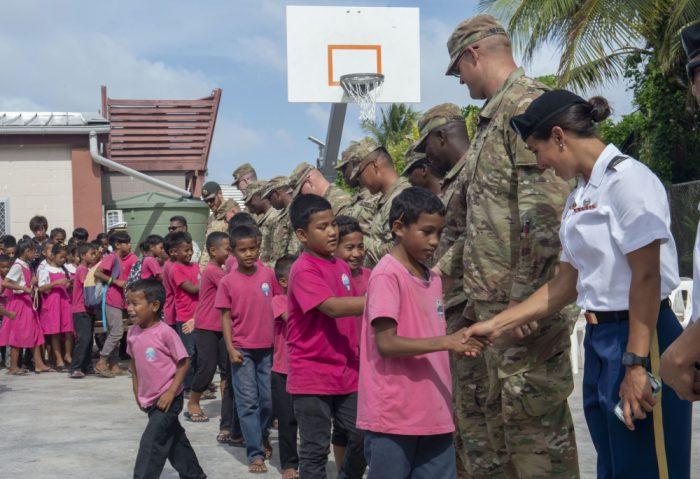Washington’s Pacific islands strategy shouldn’t focus solely on China
Posted By Alan Tidwell on May 6, 2019 @ 11:00

China’s influence in the Pacific creates a paradox for the formation of US policy towards Pacific island nations. If Washington focuses only on China’s involvement in the Pacific, it risks alienating the islands. Yet without mention of China, many US policymakers will remain uninformed and uninterested. The challenge the US faces is to develop a Pacific islands policy aimed at checking Chinese influence, while not making that the obvious and exclusive goal.
The solution is to address the needs of Pacific island states, advancing both their interests and those of the US and its allies.
China’s involvement in the Pacific has nudged Washington to pay closer attention. It has also created a problem for the US, reflected in House resolution 1157 [1] (2018), with the long-winded title ‘Reaffirming the strong commitment of the United States to the countries and territories of the Pacific islands region’. It gives voice to the longstanding and deep link between Pacific islanders and the US, and echoes the 2018 Boe Declaration [2] on climate change and human security.
The resolution, however, goes on to express concerns over China’s increased influence in the Pacific region, the threat of expanded Chinese military involvement and the placement of acoustic sensors on the ocean bottom near Guam and Yap. Australian and New Zealand diplomats, in keeping with their countries’ ‘step-up [3]’ and ‘reset [4]’ programs, worked to ensure that the resolution didn’t focus exclusively China. They succeeded in having language inserted that reflected the broader regional concerns of climate change and human security.
These same tensions were echoed at the recent Pacific Islands Roundtable [5], hosted by Georgetown University’s Center for Australian, New Zealand and Pacific Studies.
The US hasn’t been indifferent to the needs of Pacific island nations, but its attention has been episodic at best. Since 2017 there has been an uptick of interest. In April 2017, early in the Trump administration, Vice President Mike Pence stopped in American Samoa after his visit to Asia and Australia. Secretary of the Interior Ryan Zinke attended the 2018 Pacific Islands Forum leaders’ meeting.
Then, at the November 2018 APEC leaders’ meeting in Port Moresby, the US, Japan, Australia and New Zealand agreed to collaborate on a project to provide electricity to 70% of Papua New Guinea. The US, PNG and Australia also announced that they’d upgrade the naval base on Manus Island. In the same month, the US National Security Council created the role of director of Oceania and Indo-Pacific security; in years past, the Pacific had been folded into the Asia directorship.
History has in some ways complicated US relations in the Pacific. Hawaii and the territories of Guam and American Samoa came under US control well before World War II, whereas the Northern Marianas Islands, the Federated States of Micronesia, the Marshall Islands and Palau trace their US connections to the post-war era. Micronesia, the Marshall Islands and Palau are ‘freely associated states’ that were part of the Pacific trust territory governed by the US after World War II.
Three federal departments (State, Defense and Interior) share primary responsibility for the Pacific territories and freely associated states. In addition, the lion’s share of US aid in the Pacific goes to the freely associated states. Even with these deep links, the US nevertheless has trouble focusing on the Pacific islands. A former US official who covered the Asia–Pacific cynically observed that, in an average work week, they got attention late on Friday afternoons.
Australia and New Zealand have both taken steps to elevate Washington’s consideration of the Pacific islands. Australia has a diplomat as lead on the islands at its embassy in Washington. In December 2018 New Zealand’s foreign minister, Winston Peters, gave a speech [6] in Washington urging the US to do more in the region.
The Pacific islands diplomatic community is small and not well resourced to undertake the heavy lifting required in Washington. Many of the diplomatic missions reside in New York and are jointly accredited to both the UN and Washington. Nonetheless, some representatives have had very long service. Palau’s ambassador, Hersey Kyota [7], for example, has been in Washington since 1997. So, while not having large outposts in the US, some of these diplomats have a deep understanding of the ways of Washington.
Diplomats from nations throughout the Pacific ask that the US not see the islands as a bulwark against China, but rather as partners in addressing the needs of the people of the Pacific.
As one Pacific diplomat observed, ‘We’re not just flyover states, there are people living there.’
Article printed from The Strategist: https://aspistrategist.ru
URL to article: /washingtons-pacific-islands-strategy-shouldnt-focus-solely-on-china/
URLs in this post:
[1] House resolution 1157: https://www.congress.gov/bill/115th-congress/house-resolution/1157/text
[2] Boe Declaration: https://www.forumsec.org/boe-declaration-on-regional-security/
[3] step-up: https://dfat.gov.au/geo/pacific/engagement/Pages/stepping-up-australias-pacific-engagement.aspx
[4] reset: https://www.lowyinstitute.org/publications/winston-peters-new-zealand-pacific
[5] Pacific Islands Roundtable: https://canzps.georgetown.edu/https%3A//canzps.georgetown.edu/pacificislandsroundtableheldatgeorgetown
[6] gave a speech: http://www.scoop.co.nz/stories/PA1812/S00195/speech-peters-pacific-partnerships-georgetown.htm
[7] Hersey Kyota: http://glispa.org/about/board-members/217-h-e-hersey-kyota
Click here to print.